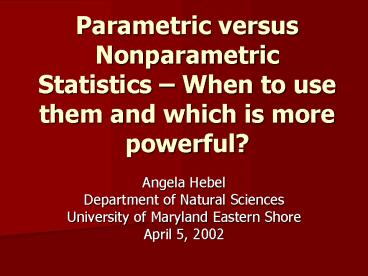Parametric versus Nonparametric Statistics - PowerPoint PPT Presentation
1 / 18
Title:
Parametric versus Nonparametric Statistics
Description:
Measurement. What are the 4 levels of measurement discussed in Siegel's chapter? ... Compare two variables measured in the same sample ... – PowerPoint PPT presentation
Number of Views:3562
Avg rating:3.0/5.0
Title: Parametric versus Nonparametric Statistics
1
Parametric versus Nonparametric Statistics When
to use them and which is more powerful?
- Angela Hebel
- Department of Natural Sciences
- University of Maryland Eastern Shore
- April 5, 2002
2
Parametric Assumptions
- The observations must be independent
- The observations must be drawn from normally
distributed populations - These populations must have the same variances
- The means of these normal and homoscedastic
populations must be linear combinations of
effects due to columns and/or rows
3
Nonparametric Assumptions
- Observations are independent
- Variable under study has underlying continuity
4
Measurement
- What are the 4 levels of measurement discussed in
Siegels chapter? - 1. Nominal or Classificatory Scale
- Gender, ethnic background
- 2. Ordinal or Ranking Scale
- Hardness of rocks, beauty, military ranks
- 3. Interval Scale
- Celsius or Fahrenheit
- 4. Ratio Scale
- Kelvin temperature, speed, height, mass or weight
5
Nonparametric Methods
- There is at least one nonparametric test
equivalent to a parametric test - These tests fall into several categories
- Tests of differences between groups (independent
samples) - Tests of differences between variables (dependent
samples) - Tests of relationships between variables
6
Differences between independent groups
- Two samples compare mean value for some
variable of interest
Parametric Nonparametric
t-test for independent samples Wald-Wolfowitz runs test
Mann-Whitney U test
Kolmogorov-Smirnov two sample test
7
Mann-Whitney U Test
- Nonparametric alternative to two-sample t-test
- Actual measurements not used ranks of the
measurements used - Data can be ranked from highest to lowest or
lowest to highest values - Calculate Mann-Whitney U statistic
- U n1n2 n1(n11) R1
- 2
8
Example of Mann-Whitney U test
- Two tailed null hypothesis that there is no
difference between the heights of male and female
students - Ho Male and female students are the same height
- HA Male and female students are not the same
height
9
Heights of males (cm) Heights of females (cm) Ranks of male heights Ranks of female heights
193 175 1 7
188 173 2 8
185 168 3 10
183 165 4 11
180 163 5 12
178 6
170 9
n1 7 n2 5 R1 30 R2 48
U n1n2 n1(n11) R1
2 U(7)(5) (7)(8) 30
2 U 35 28 30 U 33 U n1n2 U U
(7)(5) 33 U 2 U 0.05(2),7,5 U
0.05(2),5,7 30 As 33 gt 30, Ho is rejected
Zar, 1996
10
Differences between independent groups
- Multiple groups
Parametric Nonparametric
Analysis of variance (ANOVA/ MANOVA) Kruskal-Wallis analysis of ranks
Median test
11
Differences between dependent groups
- Compare two variables measured in the same sample
- If more than two variables are measured in same
sample
Parametric Nonparametric
t-test for dependent samples Sign test
Wilcoxons matched pairs test
Repeated measures ANOVA Friedmans two way analysis of variance
Cochran Q
12
Relationships between variables
- Two variables of interest are categorical
Parametric Nonparametric
Correlation coefficient Spearman R
Kendall Tau
Coefficient Gamma
Chi square
Phi coefficient
Fisher exact test
Kendall coefficient of concordance
13
Summary Table of Statistical Tests
(Plonskey, 2001)
14
Advantages of Nonparametric Tests
- Probability statements obtained from most
nonparametric statistics are exact probabilities,
regardless of the shape of the population
distribution from which the random sample was
drawn - If sample sizes as small as N6 are used, there
is no alternative to using a nonparametric test
Siegel, 1956
15
Advantages of Nonparametric Tests
- Treat samples made up of observations from
several different populations. - Can treat data which are inherently in ranks as
well as data whose seemingly numerical scores
have the strength in ranks - They are available to treat data which are
classificatory - Easier to learn and apply than parametric tests
Siegel, 1956
16
Criticisms of Nonparametric Procedures
- Losing precision/wasteful of data
- Low power
- False sense of security
- Lack of software
- Testing distributions only
- Higher-ordered interactions not dealt with
17
Power of a Test
- Statistical power probability of rejecting the
null hypothesis when it is in fact false and
should be rejected - Power of parametric tests calculated from
formula, tables, and graphs based on their
underlying distribution - Power of nonparametric tests less
straightforward calculated using Monte Carlo
simulation methods (Mumby, 2002)
18
Questions?































